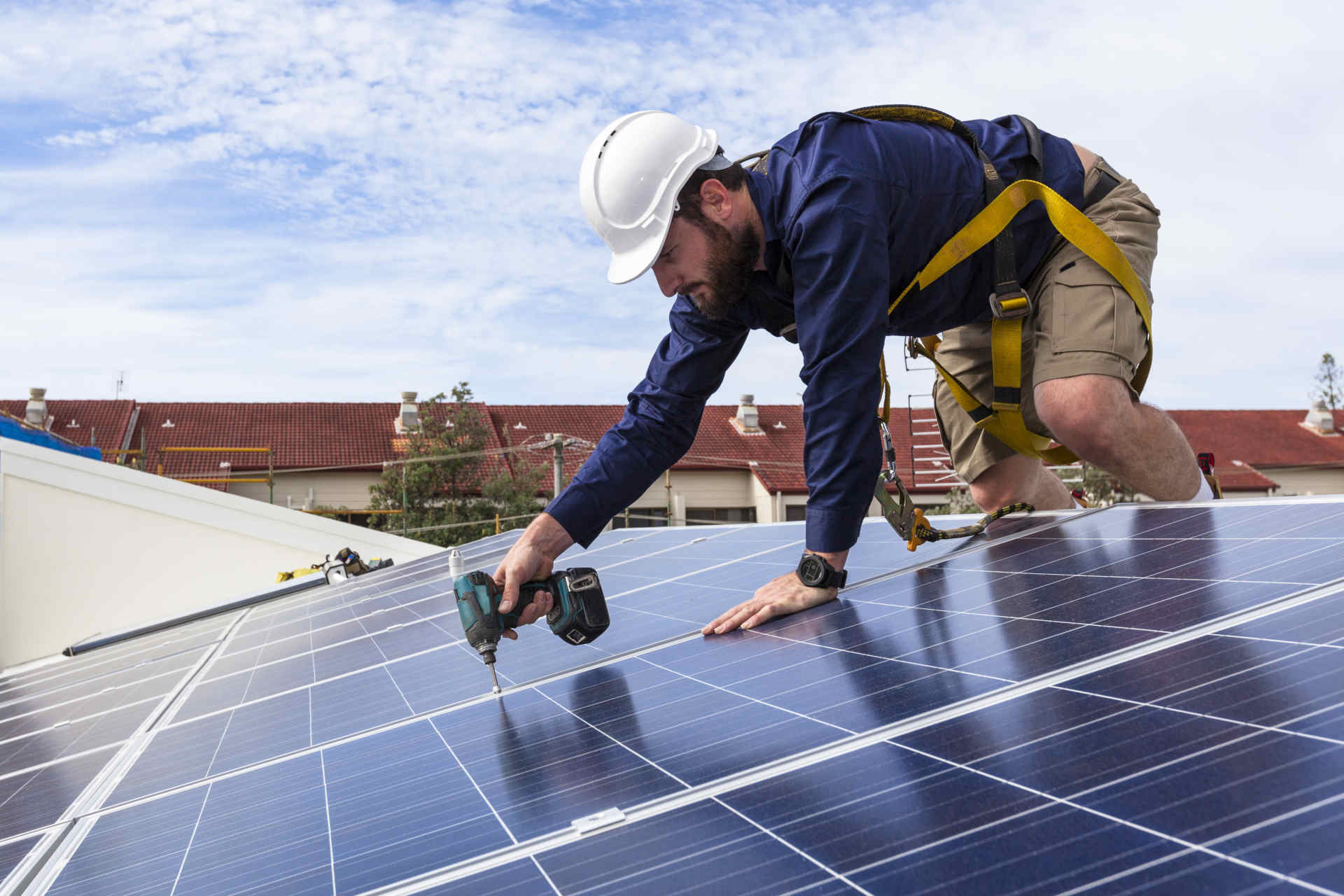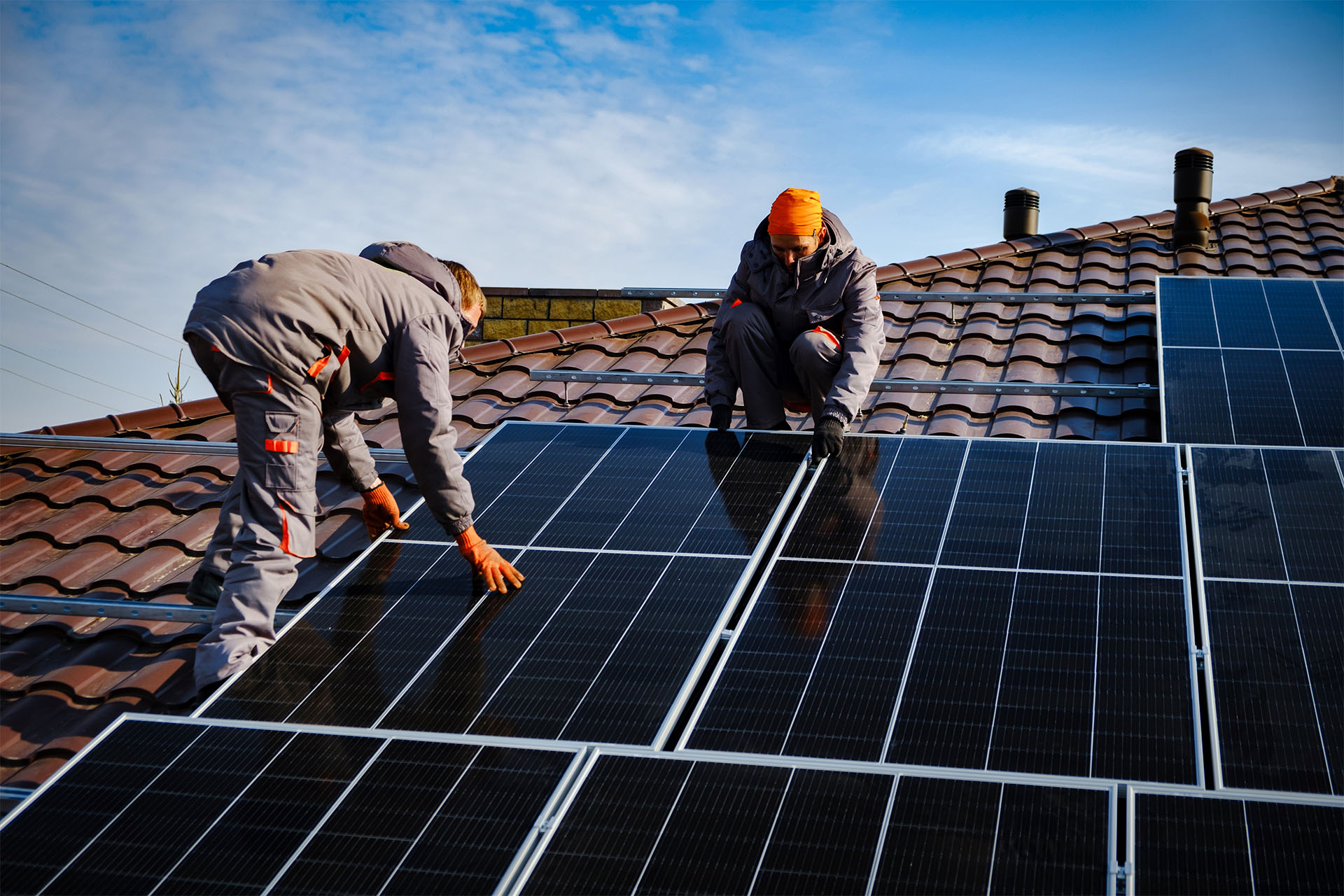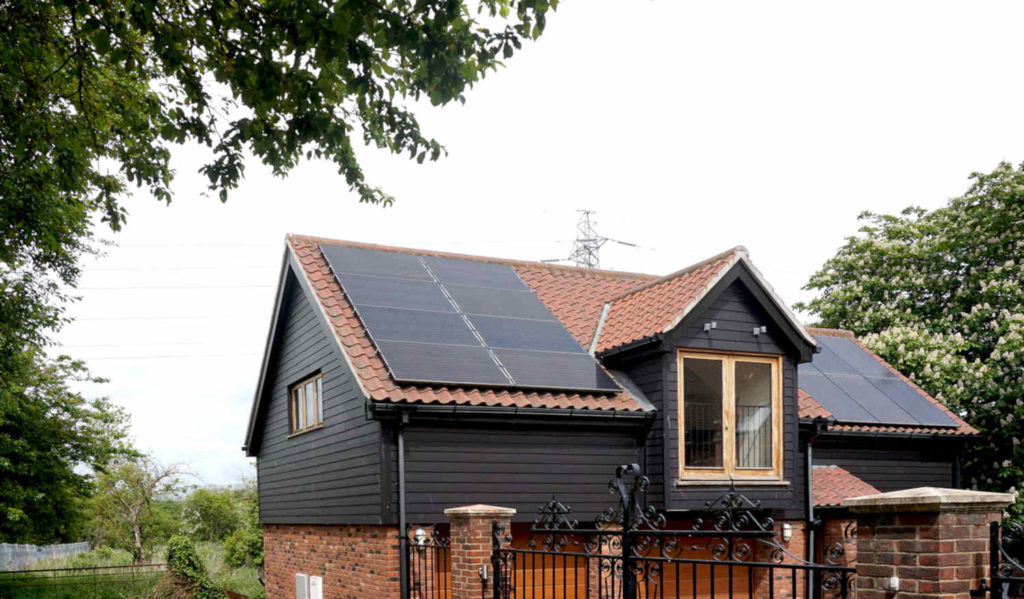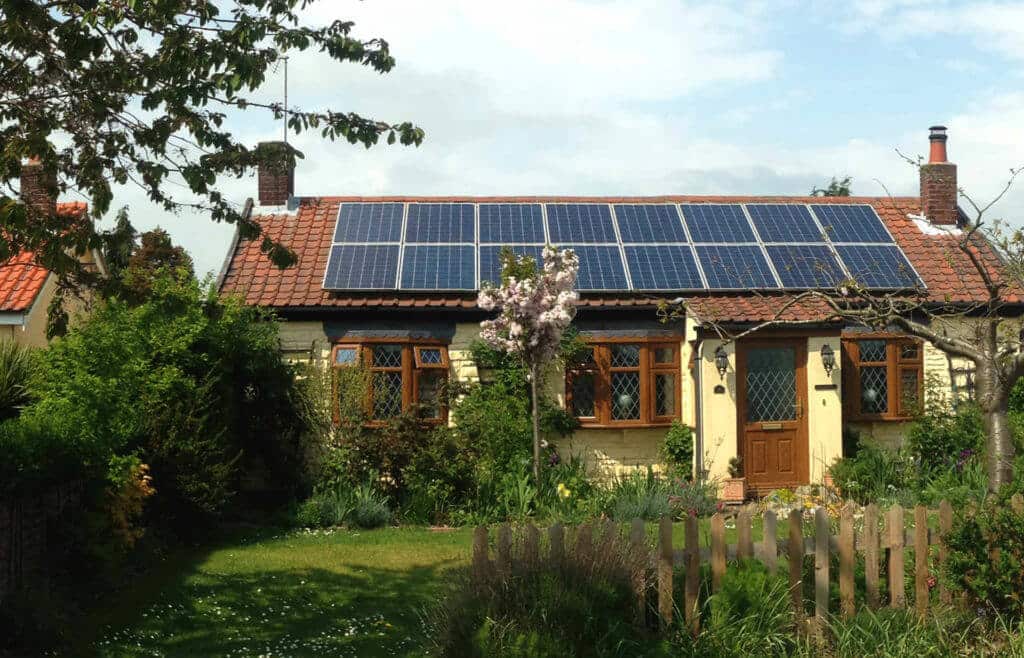Last updated on April 29th, 2024
How much does solar panel installation cost?

Want to save on your energy bills? Or just looking to do your bit for the planet? By getting solar panels installed, you can do both – solar panels could save you between £200 - £500 per year and reduce your carbon footprint in one fell swoop!
Keep reading to see a breakdown of the typical solar panel installation costs in the UK.
If you’re already sold on solar panels, then go right ahead and find a trusted solar panel installer to help you harness the power of the sun.

You’ll only find trades who meet our high standards and pass our quality checks on Checkatrade.
How much do solar panels cost?
The cost of solar panels per kW system vary. The price depends on the type and size of the system you choose. As an estimate using the most common size, you’re looking at around £8,000 for a 4kW photovoltaic (PV) system.
Here are the costs associated with a few different system sizes and types:
| System | Estimated cost | Number of 250W panels | Roof area required |
|---|---|---|---|
| 3kW PV system | £6,000 | 12 | 20m² |
| 4kW PV system | £8,000 | 16 | 27m² |
| 5kW PV system | £9,000 | 20 | 33m² |
| 6kW PV system | £10,000 | 24 | 40m² |
| Solar thermal system (3.6m²) | £5,000 - £6,000 |
Our costs are ballpark averages – get a local tradesperson to quote now
As you can see, the bigger the size of your solar panel system, the higher your solar panel installation cost will be. With this in mind, you might be tempted to purchase a smaller system, but don’t fall into this trap! Solar panel systems with higher kW can generate more electricity, and this means you’ll be able to save more money in the long run.
The exception is solar thermal panels. Unlike photovoltaic (PV) systems (what we normally refer to when we talk about solar panels), solar thermal panels don’t convert sunlight into electricity. Instead, they use sunlight to provide heat for hot water and home heating systems.
Solar panel installation labour cost
You can expect the labour costs to install the solar panels to be included in the quote usually. But you can usually calculate what the labour costs are for solar panel installation:
| Number of installers | Days to install | Labour cost |
|---|---|---|
| 2 | 1 | £600 |
| 2 | 2 | £1,200 |
| 2 | 3 | £1,800 |
You can usually expect to pay between £300 for each day of solar panel installation.
Usually, there will be two people installing your system, which comes to around £600 per day. Solar panels are usually installed on your roof in a single day, but larger systems will often take more than one day to install, which can cause labour costs to climb.
Getting solar panel installation quotes
Different companies will charge different amounts for solar panel installation. So, we’d recommend contacting at least three installers to get their prices. This will help you to gain a better understanding of the prices in your local area.
With 3 or more quotes, you’ll be able to compare their rates and reviews to find the price and service that works for you.
Get three quotes at the click of a button!
To make it easier for you, just use our request a quote feature. We’ll take a few details about what you’re looking for, and we’ll send them to solar panel installers in your area. Then, they’ll get in touch with some quotes for you to pick from!
Factors affecting your solar panel installation cost
As you can probably tell, there’s no easy answer as to exactly how much your solar panel installation will cost. Instead, your overall cost will depend on a number of factors. Here are the key ones:
Type of panels
Solar PV panels consist of semi-conducting silicon-based cells covered in glass. However, there are different types of solar PV panels, with the variation being the silicon itself and the kind of glass—the closer the alignment of the silicon molecules, the more efficient the panel.
The three main types of solar panels are:
1. Monocrystalline solar panels
These are the most efficient and most expensive type, converting more energy and getting more from lower light levels with more outstanding durability. As they’re more efficient, these solar panels tend to require less space on your roof.
2. Polycrystalline solar panels
These consist of cells where many silicone crystals are bonded together. They tend to be cheaper to produce (and are more affordable for homeowners to buy), but they also tend to be less efficient and less durable than monocrystalline cells.
3. Thin-film solar panels
These thin, flexible panels are less noticeable than monocrystalline or polycrystalline panels. They tend to be cheaper than other kinds of solar panels, but you’ll usually pay a similar amount overall as you’ll need more panels to cover a much bigger surface area to generate the same amount of energy.
The flexibility of thin-film panels makes them suitable for many different uses. For instance, they can be moulded into solar roof tiles to give a seamless finish. Our solar roof tiles cost guide has more information.
Your installer may also give you a choice between plate and strengthened glass. Plate glass is the standard (and cheaper) solution, but strengthened glass will be less likely to be damaged and can even improve the efficiency of the silicon cells it is designed to protect.
Amount of energy generated
Your solar panel installation cost will also depend on what size system you go for. The larger your solar panel system is, the more it will cost to install (although the price per kW will be less). The right size for you will depend on the size of your home and how much electricity you tend to use.
The power rating of panels varies by size and type, but typical panels have a 0.25kWp rating, meaning that they can generate 0.25kW at peak levels. Most domestic installations tend to be either 3kWp (12 panels) or 4kWp (16 panels).
For context, your kettle requires 3kW. Typically, installers expect panels to generate 80% of their peak capacity. So, at their best, if all the panels were generating well for 8 hours on a sunny summer’s day, you would create a maximum of 19 or 25kWh (kWh = kilowatts x hours generated) per day.
Installers also work based on around 50% of the generated electricity being unused in the home and exported to the grid depending on usage patterns. A 3kW system would, therefore, typically produce around 2,600 kWh during a year, of which half would be used in the home and half exported (as the panels produce energy when you need it least). A 4kW system might hope to produce around 3,400kWh over a year.
According to OFGEM, the typical house uses between 3,200 and 4,100kWh a year.
Your property
Properties come in all different shapes and sizes, and this will have a bearing on your solar panel installation cost.
Firstly, bigger properties tend to use more energy, affecting the size of the system you decide to go for (and therefore its cost). Similarly, the direction that your roof faces will influence how efficiently your panels can generate electricity – roofs that face south, south-west and south-east are considered highly efficient, whereas roofs that face north may struggle.
On top of this, the access to your property, the strength of your roof and the angling of your panels will all affect how easy your solar panel system is to install. Harder installations will take more time, adding to your labour costs. Labour costs also vary across the country, so be sure to get quotes from local companies to find out how much you can expect to pay for solar panel installation in your area.
Additional components
Adding solar batteries or other additional features will increase your solar panel installation costs. However, it will often be more cost-effective to buy them at the same time as you purchase your solar panels than it will be to add them later on. Plus, some additional features could help you to save more money on your energy bills in the long run.
For instance, solar batteries let you store the energy your solar panels have generated so that you can use it at a later date. This can make you less reliant on the national grid, by helping you to use more of the renewable energy you’ve generated yourself. A standard 4kWh battery could cost you around £5,000 – read our solar battery storage system cost guide for more ballpark costs.
We would always advise chatting to your solar panel installer about additional components. That way, you can gain a better understanding of whether any specific additions would be recommended to help you make the most of your new solar panel system, given your own unique circumstances.
How much can you save with solar panels?
There are two ways you save money with solar panels:
- Savings in electricity bills: A 4kWp solar panel can save you around £200 - £500 in electricity bills.* These savings add up, offsetting the installation cost in a few years. This estimate is based on July 2023 electricity prices
- Selling unused electricity: Any solar power you generate but don’t use can be exported back to the National Grid. Depending on the supplier you choose, you can generally earn up to £200 - £500. There are a few standout tariffs, particularly the Intelligent Octopus Flux from Octopus offering much higher export rates for existing customers with solar panels and battery storage
Solar panel electricity calculator
Of course, every household is different so it’s hard to say exactly how much money you could save from installing solar panels. When you’re estimating your savings, it’s worth bearing in mind a few key factors, including:
- How much electricity your household uses
- When you use your appliances
- How efficient your solar panels are
- Whether you receive an income from solar panel grants like SEG (we’ll go into this below)
To maximise the amount you can save on your energy bills, it’s best to use appliances like your washing machine and dishwasher when the sun is out (unless you’ve invested in a solar battery). Using your appliances while your solar panels are active will enable you to run them using the energy you’re generating. Small changes like this can make a big difference to your energy bills!
Reduce your solar panel costs with SEG payments
SEG stands for smart export guarantee. It’s a scheme that was introduced by the UK government in 2020, which allows you to get paid for the solar energy you generate but don’t use. This energy then gets used by the National Grid, allowing other homes to make use of the renewable energy that’s been generated by your solar panels.
If you generate solar electricity and wish to receive payment for the electricity you export to the National Grid, you simply need to apply to an SEG Licensee (an electricity supplier that offers an SEG tariff). At the moment, there are 15 companies that are licensed to offer SEG tariffs. It’s worth shopping around to get the best rates as, if you export lots of energy to the National Grid, these can make a big difference to how much you earn.
The SEG replaces a previous scheme known as the feed-in-tariff (FIT) scheme, which closed to new applicants in March 2019. The FIT scheme was more generous than the SEG and paid households for every unit of electricity generated. However, if you’re thinking about installing solar panels, you can still save up to 6.4p per kWh and claw back your investment in 10 years, depending on your circumstances. Which brings us onto…
How long do solar panels take to pay for themselves?
In the UK, it typically takes around 10 and a half years to break even after installing solar panels. But this will of course depend on the type of solar panel system you go for, its size, your export tariff, how much energy you use, and current electricity prices. Some homeowners may find that they’re able to break even after just 6 years, particularly with larger systems that can generate more electricity and therefore greater savings.
Either way, after you’ve broken even, the huge cost savings you get from lower energy bills and from the SEG will all go straight into your pocket to increase your expendable income. So, as long as you’re not planning on moving home in the next few years, the initial cost of solar panel installation will certainly be worth it in the long run.
Just make sure to regularly maintain and clean your solar panels to ensure that they last long into the future and continue to bring you all those lovely benefits!
What does solar panel installation involve?
Sold on solar panel installation? In that case, you’re probably wondering what the job involves.
Solar panels are usually installed on your roof in a single day, unless you’re forking out on a particularly large system. The area to be covered by the solar panel array will be cleared of tiles and the solar panels fixed to the existing battens with aluminium brackets.
Solar panels tend to sit slightly proud of the roof, and good installers will consider potential wind loading factors (only really an issue in exposed locations).
Step-by-step solar panel installation guide
Here are the steps your contractor will typically take to install your solar panels.
- Erect the scaffolding – This is essential for the safety of the installation team. It’s worth checking that the cost for installing the scaffolding is included and that there’s enough room outside your house for the scaffolding tower
- Attach roof anchors – The roof anchors are there to hold the frame for the solar panels, and the type of anchor used will be determined by the type of roof tile fitted. The installation team will start by lifting some of the tiles on your roof and fixing the roof anchors to the rafters. The installer should have already gone into the loft during the survey to check that the rafters and the roof are suitable for installing solar panels
- Attach the frame – The aluminium frame (or solar panel rails) attach to the anchors, which run vertically and horizontally across the roof
- Install the solar panels – The panels clamp loosely to the frame, and then they’re tightened once the installer has positioned them at their optimal angle
- Solar panel wiring – The panels usually come prewired from the manufacturer, but they still need to be connected to an inverter. Whilst the main installation team is busy installing solar panels onto the roof, an electrician will set up the inverter in your house (usually in the loft). The inverter converts generated electricity – direct current (DC) – into usable alternating current (AC). After that, your free electricity is ready to be used by electrical appliances in the house. You’ll need to switch off the electricity at the fuse box before this step
- Final checks – The electrician makes the final connections to the consumer unit and typically installs the generation meter near the fusebox. Once this is completed, the electrician switches the electricity back on to test the solar installation and confirms that all the units are performing as expected
- Receive Microgeneration Certification Scheme (MCS) – You’ll usually receive your certification within two or three days, once the installer has registered the solar installation with MCS
Expert solar panel tips
When considering your options for solar panel installation, it’s always worth taking advice from a Checkatrade expert:
Shading
String inverters limit the output of the entire solar PV system to the performance of the worst-performing panel. So a slight shadow from a chimney, tree or nearby lamp post will make a surprising amount of difference to your production over the year.
This issue can be overcome with an installation where the solar panels work individually, using either power optimisers or micro-inverters. One of our colleagues has a chimney on his roof. Using the online monitoring software, we can tell that he would have produced around a third less if he had not had micro-inverters.
Batteries
Batteries can reduce your reliance on the National Grid, which can be ideal for homeowners who want to become more self-sufficient. However, they can be hard to justify from a financial perspective when looking at the potential savings vs their upfront cost. If you’re looking for the most financially savvy way forward, you might be better off spending your budget on increasing the amount of energy you’re able to generate, for instance by installing additional solar panels or focusing on individual panel optimisation.
That said, a range of new lithium-ion (Li-ion) batteries are now available that make the promise of battery storage a practical reality. The best known of these is the Tesla Powerwall, which holds up to 14kWh (around 1.5 days’ typical generation in summer) and can output 5kW continuously and 7kW spot energy.
In the next year or two, the price of household batteries is expected to fall to a more justifiable level, so they might be worth adding to your solar PV system at a later date.
How can I find a good solar panel installer?
Look for an experienced installer who has performed installations on similar local properties. Ensure they have not caused damage to existing roof tiles and they are willing to handle everything from quotation to finished installation on your behalf. An installer should be fully qualified and certified.
To find an expert, qualified solar panel installer, start your search by reading our hiring guide and then search for a recommended installer on Checkatrade.
FAQs
How do solar panels work?
Solar panels benefit from direct sunlight but still generate using daylight, not heat. That means they can generate (smaller amounts of energy) even on cloudy winter days.
As daylight hits the cells on the panels, it is converted into direct current (DC) energy. This passes through an inverter to turn it into the AC energy we use around the house. Excess unused energy could be fed back to the National Grid.
Are my home and roof suitable for solar panels?
Solar panels harvest solar energy in almost all circumstances, but maximising the benefit is all about looking at your own home’s situation.
As a northern hemisphere country, the best orientation for solar panels in the UK is south-facing. This means the panels can enjoy the sun as it moves through the eastern, southern and western sky during the day. The height of the sun in the sky changes based on the season and the panels work at maximum efficiency when angled directly at the sun.
The ideal pitch of solar panels would need adjusting throughout the year – steeper in winter (as the sun is lower) and flatter in summer. Clearly, that is impractical for most people, so experts tend to agree that around 30˚ is the best compromise. Again, solar panels will generate some energy in almost all instances.
Panels vary in size, but the typical panel is 1m x 1.65m. Typical 3kWp arrays of panels (12 standard panels) will therefore need 20m2 of roof space. The amount of useable roof space varies with different houses. Still, it’s possible that if you live in a small mid-terraced home, you might only have between 15-18m2 of potential space – so factor that into your planning.
Do solar panels need maintenance?
Solar panels work more efficiently when they are cleaner. The taller the pitch of the roof, the less likely the panels are to gather dust or bird droppings. The relatively large and regular rainfall in the UK also tends to give them regular rinsing.
However, if your panels regularly get bird droppings on them, you will need to clean them. Ideally, this should be around every six months.
The good news is that many installers offer self-cleaning solar panels. They consist of a hydrophobic coating on the glass, which stops raindrops from sticking to the surface. As they drop off, they clean the glass very effectively.
From a maintenance perspective, it’s also essential to ensure that nearby tree branches are not growing too close to the panels over the years. Overhanging leafy branches will affect your panels’ output.
How much does it cost to clean solar panels?
Solar panel cleaning costs can be around £15 per panel.
When it comes to solar panel maintenance, it’s sensible to pay for an annual service, which will ensure your panels are in good working order and pick up on any issues before they turn into more expensive problems. An annual service typically costs around £150 .
The most expensive maintenance cost you’ll see is the cost of replacing the inverter. This will usually need doing once every 25 years and costs approximately £1,200.
Will having solar panels increase my home’s value?
Generally, the answer is no. Estate agents are unlikely to offer a higher valuation because a property already has solar panels installed, although solar panels certainly won’t detract from a house’s value either.
That said, it’s a grey area and the age of the solar panels, whether they’re owned by another company, and their effect on the property’s appearance could all have a bearing. Our guide on whether solar panels add value to your house goes into more detail.
Will I need planning permission to install solar panels on my home?
The installation of solar panels is part of your Permitted Development Rights – meaning you don’t need to gain formal planning consent to install them.
There are exceptions to this rule, such as limiting the installation of panels to the rear of a property in a conservation area, and prohibiting them entirely if your home is listed. Your home might also be exempt from Permitted Development Rights under an Article 4 direction.
If you have the land and intend to install stand-alone panels in your garden rather than the roof, the array can be no bigger than 9m2 and must be at least 5m from the boundary.
What are the pros and cons of solar panels?
Pros
- Fit and forget: essentially maintenance-free and very reliable
- Guaranteed income: from selling your energy back to the National Grid (tax-free and index-linked)
- Cost savings: benefit from free energy generated from your panels
- Green: solar energy is a renewable energy source that doesn’t negatively impact the environment
- Future-proofing: an element of insulation from future energy rises
- Payback: the payback time on the cost of installing solar panels is reducing now as the energy price cap increases
Cons
- Installation costs: increasingly marginal financial benefits of installation
- Aesthetics: don’t add much to the overall appearance of a house
- Waste: don’t generate energy when it’s most needed – there’s a lot of wasted energy
Is it worth it to install solar panels in your home?
The electricity that solar panels generate is a natural source of energy that can power your home. The initial solar panel installation cost may seem high, but savings made over time make it a worthwhile investment.
You can get free electricity with solar panels, which can significantly reduce your utility bills. Plus, you can make money by exporting spare energy to the National Grid. Whether or not to invest in solar panels is a decision that should be made carefully, and we recommend you get advice from a solar expert.
Are there incentives to help with the solar panel installation cost in 2024?
There are several incentives available to UK households that are considering solar panel installation.
- Energy Company Obligation (ECO4). Eligible homes can get discounted (or free) solar panels through this scheme. However, it’s only for the most energy-inefficient homes, and homeowners must meet other criteria to be eligible too
- The Smart Export Guarantee (SEG). All households that have solar panels can get paid to export their excess electricity back to the National Grid
- Zero VAT. Energy-saving materials and equipment (including solar panel supply and installation) will now have 0% VAT. Ordinarily, the VAT rate on these items would sit at 20%. The discounted rate will continue until 31st March 2027
* Saving estimates are based on a 4kWp solar panel. These savings add up, offsetting the installation cost in a few years. This estimate is based on electricity prices as of July 2023.

We check the reviews on Checkatrade are from real people, and that trades meet our high standards.
Working with professional estimators, we collate cost estimates for the common home improvement and repair jobs in the UK.
All the costs are estimates only. For accurate costs for your particular requirements, you are encouraged to reach out to professional tradespeople to receive a quote for your job.
Our estimators are Chartered Members (MRICS) of the Royal Institution of Chartered Surveyors and Members of the Chartered Institute of Building (MCIOB). See full disclaimer.





Andra ra
Thank you for all your information. Very usefull
Elizabeth cook
Extremely informative and helpful in making a decision to purchase solar panels.
Sandra
A very helpful guide to solar panel installation
M Cha
Well written in simple language, informative, excellent.
Ibrahim Aly
Very informative and detailed guide Very useful
Mark Campbell
Very insightful article and extremely helpful.